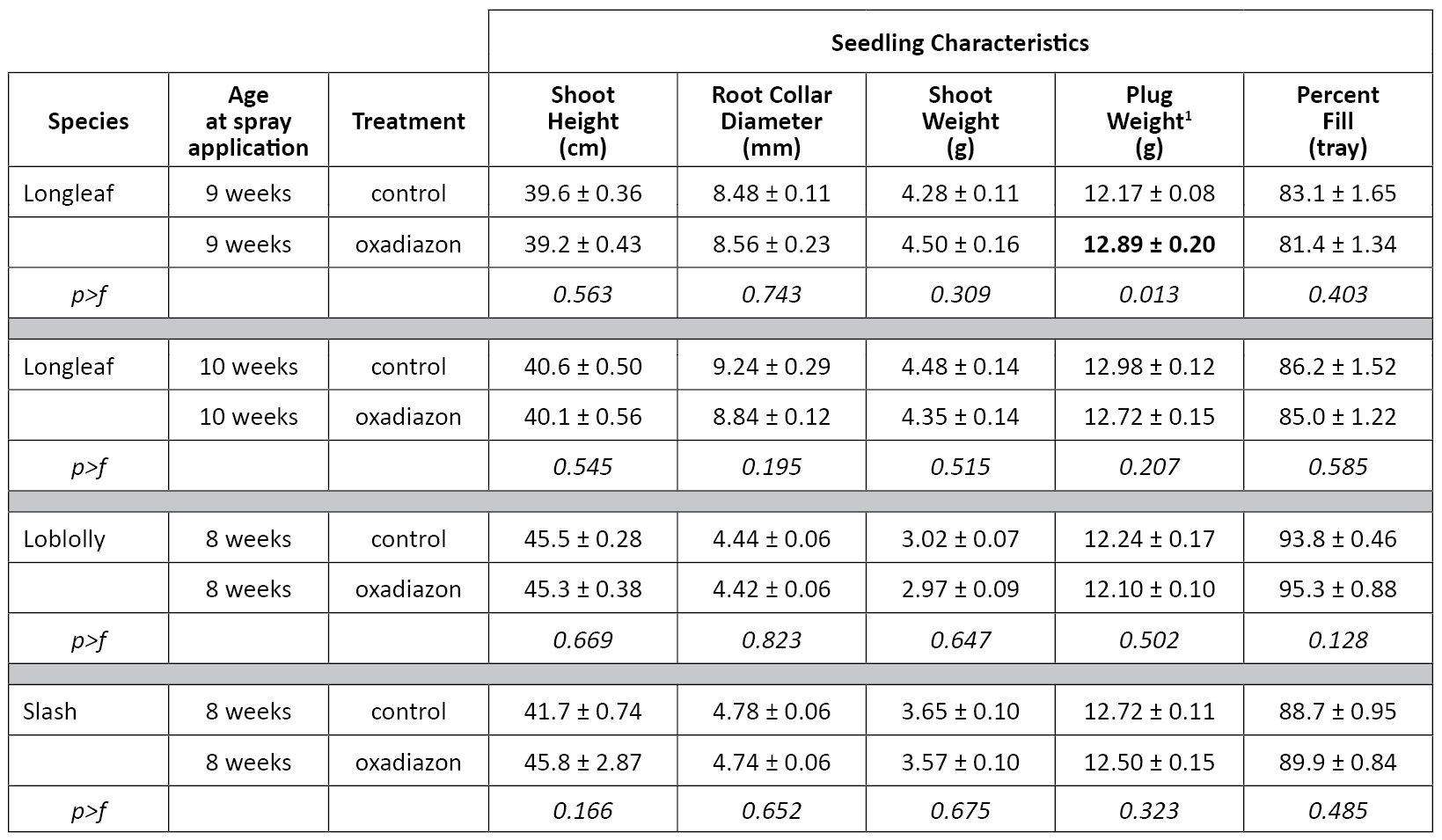Research Report 22-04 
Use of Oxadiazon in Over-the-Top Applications in Containerized Pine Growing Systems
Nina Payne, Tom Stokes, and Thomas Meeks
Introduction
The science and art of growing containerized pine seedlings for regeneration of forestland has evolved over the years, with major advances made in mechanization, container design, and media formulations among others. As growers began to construct large containerized seedling production facilities, some technical information garnered from bareroot seedling nurseries could be transferred to these new operations; however, information was lacking in other areas. One of these areas that was not as transferable was in the weed control methods used in bareroot nurseries. Rather than dealing with a fairly predictable weed seed bank in bareroot nurseries, the types and timings of weeds in containers were different.
In 2014, the Southern Forest Nursery Management Cooperative began their first weed control trials in containerized seedlings to address the problem of black willow (Salix nigra) growing in containers, which reduced the value and/or production quantities of the desired crop. Since that time, eight trials have been installed in two containerized nurseries in four pine species, evaluating the efficacy of three herbicides and their effects on the growth of pine seedlings.
That first trial began in 2014 to test the capability of a herbicide (indaziflam) to reduce or prevent unwanted black willow populations growing in the containers with pine seedlings (Enebak and Payne, 2015). Over a six year period, the herbicide oxadiazon (Ronstar®FLO) was identified as being safe for application on newly-sown pine containers while providing control of black willow in those same containers (Payne et al, 2019 and 2020). Oxadiazon works to kill plant seedlings as they germinate and come into contact with the herbicide. These trials were designed to apply herbicides in a pre-emergent setting, that is, before weeds emerged. This herbicide was applied at sowing of the containers which is pre-emergent to the desired crop emerging. A pre-emergence treatment is defined as ‘any treatment made prior to emergence of a specified crop or weed’ just as post-emergence treatments are those ‘made after emergence of a specified crop or weed’ (Klingman and Ashton, 1975). Spray applications were made to newly sown and capped containers in trays but prior to their placement on benches or tables. The germination of pine seedlings was not affected by the herbicide as weed species were.
Predictably, the next step in herbicide testing in containers has proven to be in post-emergent applications. For purposes of this trial, this term is being used to describe the application of the herbicide after emergence of the pine seedling in the container, with or without weed emergence. Currently, the most commonly used weed control method in containerized growing systems after pines have emerged is hand-weeding, requiring hours of manual labor that may or may not be available when needed. This trial was initiated at the request of a container nursery manager who had experienced an infestation of oxalis in containers at approximately 9 to 10-weeks post-sowing.
Because oxadiazon had been shown to be safe when applied to containerized pines at sowing, it was selected for use in this trial. The current Ronstar®FLO label allows for pre-emergent (before weeds have emerged) applications in conifer nurseries, and prior to weed seed germination as a directed spray to the soil or in over-the-top applications in established plants. The purpose of this study was to evaluate the efficacy of oxadiazon in controlling weeds in containers later in the growing season, while also determining the safety of applying the herbicide over the top of three species of pine seedlings.
Table 1. Containerized pine seedling characteristics treated with 40 ounces per acre of oxadiazon (Ronstar®FLO) in post-emergent applications.
 1Bold means within a seedling characteristic indicate significant treatment difference from that of the nontreated control at that rate according to Dunnett’s T-test at alpha = 0.05.
1Bold means within a seedling characteristic indicate significant treatment difference from that of the nontreated control at that rate according to Dunnett’s T-test at alpha = 0.05.
Methodology
This trial was installed at the container nursery owned and operated by Meeks' Farm and Nursery near Kite, Georgia. Three pine species were included in the study: longleaf, loblolly, and slash pine. Spray applications of the herbicide were made on the same day (May 27, 2021) in all species. Because of differences in sowing dates, the loblolly pine used was 8 weeks old, the slash pine was 8 weeks old, one longleaf set was 9 weeks old, and a second set of longleaf was one week older at 10 weeks. For each set, twenty (20) trays were included in the installation. Each tray represented a replication in the study design and statistical analysis. Ten (10) of these trays were designated to be non-treated controls and ten (10) trays were sprayed with 40 ounces per acre of oxadiazon (Ronstar®FLO) by SFNMC personnel. A total of 80 trays were used in this study.
In September 2021, visual inspections showed no differences in seedling characteristics of the treated and non-treated seedlings in all three species. The nursery manager also reported that the weed pressure he had anticipated based on the previous year’s activity did not materialize, with very few weeds present in his entire crop.
In November 2021, counts were made of the number of seedlings in each tray for an evaluation of tray density. Samples of ten (10) seedlings from each tray were then randomly selected and transported to the SFNMC laboratory for analysis, with a total of 800 seedlings measured. Because weed pressure was low, no measures of weed populations were made during or near the end of the growing season. Pine seedling measurements included height, root collar diameter, and dry weights of tops and plugs. Results of these measurements can be found in Table 1. Data was analyzed and examined using Duncan’s Multiple Range test and Dunnett’s t-test at alpha = 0.05.
Results
Longleaf pine treated at 9 weeks post-sowing:
Statistical differences in plug weights were found when comparing measurements of non-treated control seedlings with treated seedlings. The treated seedlings had plug weights 0.62 grams greater than those of non-treated seedlings. Comparisons of remaining characteristics of seedling height, root collar diameter, shoot weight, and tray density showed no differences between treated and non-treated seedlings.
Longleaf pine treated at 10 weeks post-sowing:
No differences were found in seedling characteristics measured between non-treated control seedlings and treated seedlings in these trays.
Loblolly pine treated at 8 weeks post-sowing:
No differences were found in seedling characteristics measured between non-treated control seedlings and treated seedlings in these trays.
Slash pine treated at 8 weeks post-sowing:
No differences were found in seedling characteristics measured between non-treated control seedlings and treated seedlings in these trays.
Oxalis and other weed control:
Because significant weed populations did not appear during the growing season, measurable differences on the weed control effect of Ronstar®FLO applied later in the growing season were unable to be quantified.
Management Implications
This is the first trial conducted by the SFNMC on containerized pine seedlings after they have emerged, with spray applications made over-the-top of seedlings. As such, these results should not be used as an endorsement for nursery-wide use of Ronstar®FLO in such applications. Additional studies should be conducted to confirm these results prior to large scale use of the product.
Current labeling of Ronstar®FLO recommends using rates of 1.85 to 2.8 fluid ounces per 1000 square feet (2 pounds to 3 pounds active ingredient per acre) in single applications and restricts the maximum quantity of product applied per year to 7.4 ounces per 1000 square feet, made in two applications (in heavy weed infestations) at a minimum of 40 days apart. In November 2020 and March 2022, the SFNMC staff joined discussions with the USDA and horticultural and landscape industry representatives on proposed interim decisions to change labeling of Ronstar®FLO. At the writing of this report, no proposed changes or restrictions should affect the availability of Ronstar®FLO for use in containerized growing systems in forest-tree nurseries or its use at the most commonly-used rates of 40 and 80 ounces per acre used in SFNMC member nurseries.
References
Bayer. Ronstar®FLO label. Retrieved from:
https://www.environmentalscience.bayer.us/-/media/prfunitedstates/documents/resource-library/product-labels/ronstar-flo.ashx
Enebak, S. and N. Payne. (2015). Effect of timing and rate of Marengo® (indaziflam) applications on weed control and tolerance to loblolly, longleaf, slash, and shortleaf pine seedlings grown in containers. Auburn University, Southern Forest Nursery Management Cooperative. Research Report 15-01:15p.
Klingman, G.C. and F.M. Ashton. Weed Science: Principles and Practices. New York, John Wiley & Sons, Inc. 1975.
Payne, N., R. Nadel and S. Enebak. (2019). Ronstar®FLO (oxadiazon) on loblolly and longleaf pine in a container-grown nursery. Auburn University, Southern Forest Nursery Management Cooperative. Research Report 19-05:5p.
Payne, N., R. Nadel and S. Enebak. (2020). Application of Ronstar®FLO (oxadiazon) for willow control in containerized growing systems: a summary of three years of trials. Auburn University, Southern Forest Nursery Management Cooperative. Research Report 20-02:17p.
Pickens, J., C. Marble and S. Li. “Weed Control in Container Nurseries.” Crop Protection, Alabama Extension Service. August 27, 2021, https://www.aces.edu/blog/topics/crop-production/weed-control-in-container-nurseries/. (Accessed October 19, 2021.)




